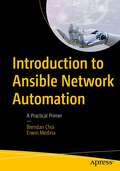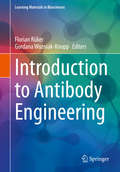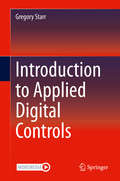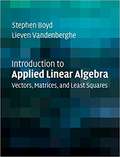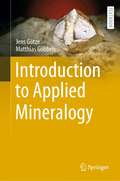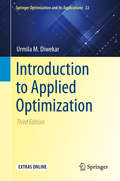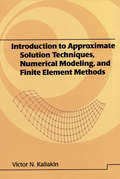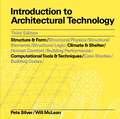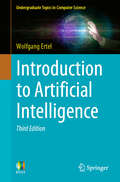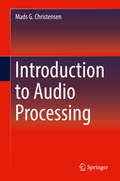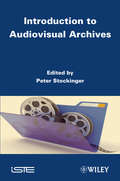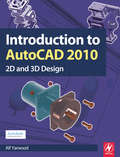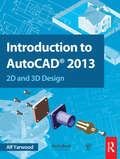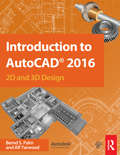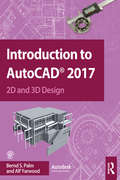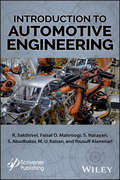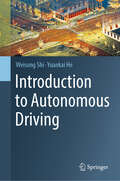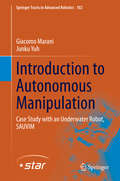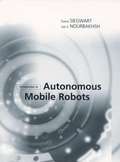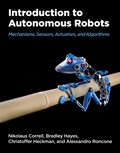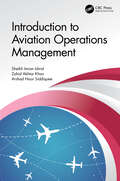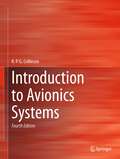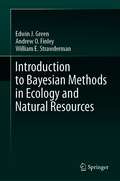- Table View
- List View
Introduction to Ansible Network Automation: A Practical Primer
by Brendan Choi Erwin MedinaThis book provides a comprehensive learning journey aimed at helping you master Ansible and efficiently automate a range of enterprise network devices, such as routers, switches, firewalls, Wireless LAN Controller (WLC), and Linux servers. Introduction to Ansible Network Automation combines the fundamentals of three books into one, covering basics of Linux administration, Ansible concepts, and Ansible network automation. Authors Brendan Choi and Erwin Medina have created a structured learning path that starts with the fundamentals and allows you to progressively enhance your skill sets with each chapter. Part I serves as an Ansible primer, guiding you through Linux basics using WSL on Windows 11 and assisting in the setup of your learning environment. Part II covers essential Ansible concepts through practical lab activities involving four Linux servers. In Part III, you will learn how to apply your Linux skills from Part I and the concepts from Part II to real-world scenarios by creating Ansible automation YAML scripts. What sets this book apart is its unique focus on Ansible and Network Automation, combined with a strong emphasis on understanding Linux. It is specifically designed for novice network automation engineers and students, assuming no prior Linux expertise, and provides first-hand experience starting from scratch. It also offers practical insights by sharing real-life examples of Ansible playbooks derived from production enterprise infrastructure, allowing you to gain an understanding of how Ansible can be effectively applied in real-world enterprise network environments. Upon completion of this book, you will have developed foundational skills in Ansible network automation and general Linux administration, and will understand how to apply this newly acquired knowledge to real-life scenarios. What You Will Learn Develop a comprehensive understanding of Ansible and its essential concepts for automating enterprise network devices and applying them to real-world scenariosMaster the basics of Ansible operations within Linux automation and progress to applying Ansible concepts specifically to network device automationExecute Ansible ad-hoc commands and playbooks for a range of network operational tasks, including configuration management, software and system updates, and upgradesWork with real-life examples of Ansible playbooks derived from actual enterprise infrastructure, gaining practical experience in writing Ansible YAML scriptsAcquire the skills to automate network operations using Ansible, streamline network management processes, and replace manual-driven tasks with directives in Ansible playbooks Who is This Book For Network, security, UC and systems engineers, as well as technical leaders, IT managers and network students.
Introduction to Antibody Engineering (Learning Materials in Biosciences)
by Florian Rüker Gordana Wozniak-KnoppThis highly readable textbook serves as a concise and engaging primer to the emerging field of antibody engineering and its various applications. It introduces readers to the basic science and molecular structure of antibodies, and explores how to characterize and engineer them. Readers will find an overview of the latest methods in antibody identification, improvement and biochemical engineering. Furthermore, alternative antibody formats and bispecific antibodies are discussed.The book’s content is based on lectures for the specializations “Protein Engineering” and “Medical Biotechnology” within the Master’s curriculum in “Biotechnology.” The lectures have been held at the University of Natural Resources and Life Sciences, Vienna, in cooperation with the Medical University of Vienna, since 2012 and are continuously adapted to reflect the latest developments in the field. The book addresses Master- and PhD students in biotechnology, molecular biology and immunology, and all those who are interested in antibody engineering.
Introduction to Applied Digital Controls
by Gregory StarrThis textbook introduces senior undergraduate and beginning graduate students of mechanical engineering to the field of digital control with an emphasis on applications. Both transform-based and state-variable approaches are included, with a brief introduction to system identification. The material requires some understanding of the Laplace transform and assumes that the reader has studied linear feedback control systems. Adopting an accessible, “tutorial” format, the text presents a clear and concise treatment of Linear Difference Equations, Discrete Simulation of Continuous Systems, Sampled Data Systems, Design using Laplace and Z Transforms, Introduction to Continuous State Space, Digital Control Design using State Space Methods (including state estimators), and System Identification using Least Squares.
Introduction to Applied Linear Algebra: Vectors, Matrices, and Least Squares
by Stephen Boyd Lieven VandenbergheThis groundbreaking textbook combines straightforward explanations with a wealth of practical examples to offer an innovative approach to teaching linear algebra. Requiring no prior knowledge of the subject, it covers the aspects of linear algebra - vectors, matrices, and least squares - that are needed for engineering applications, discussing examples across data science, machine learning and artificial intelligence, signal and image processing, tomography, navigation, control, and finance. The numerous practical exercises throughout allow students to test their understanding and translate their knowledge into solving real-world problems, with lecture slides, additional computational exercises in Julia and MATLAB, and data sets accompanying the book online. It is suitable for both one-semester and one-quarter courses, as well as self-study, this self-contained text provides beginning students with the foundation they need to progress to more advanced study.
Introduction to Applied Mineralogy
by Jens Götze Matthias GöbbelsThis textbook teaches important material and technological fundamentals in various technical systems and applied geoscientific fields. Beginning with the mineralogical characteristics of selected non-metallic raw materials and industrial minerals, this book presents the connections between properties and industrial applications and discusses the environment-relevant aspects as well as problems of biomineralogy. An introduction is given to important mineralogical and physico-chemical aspects of ceramic materials such as silicate ceramics, glass, cement, refractory materials as well as an overview about material synthesis.This makes it the first textbook to present the fundamentals of applied mineralogy as a material-related geoscience in a compact form and to show important bridges to industrial issues and approaches to solutions. It is aimed primarily at undergraduate students of geosciences and materials science, but is also suitable for related disciplines and practical applications.
Introduction to Applied Optimization (Springer Optimization and Its Applications #22)
by Urmila M. DiwekarProvides well-written self-contained chapters, including problem sets and exercises, making it ideal for the classroom setting; Introduces applied optimization to the hazardous waste blending problem; Explores linear programming, nonlinear programming, discrete optimization, global optimization, optimization under uncertainty, multi-objective optimization, optimal control and stochastic optimal control; Includes an extensive bibliography at the end of each chapter and an index; GAMS files of case studies for Chapters 2, 3, 4, 5, and 7 are linked to http://www.springer.com/math/book/978-0-387-76634-8; Solutions manual available upon adoptions.
Introduction to Approximate Solution Techniques, Numerical Modeling, and Finite Element Methods (Civil and Environmental Engineering #Vol. 9)
by Victor N. KaliakinFunctions as a self-study guide for engineers and as a textbook for nonengineering students and engineering students, emphasizing generic forms of differential equations, applying approximate solution techniques to examples, and progressing to specific physical problems in modular, self-contained chapters that integrate into the text or can stand alone!This reference/text focuses on classical approximate solution techniques such as the finite difference method, the method of weighted residuals, and variation methods, culminating in an introduction to the finite element method (FEM). Discusses the general notion of approximate solutions and associated errors! With 1500 equations and more than 750 references, drawings, and tables, Introduction to Approximate Solution Techniques, Numerical Modeling, and Finite Element Methods:Describes the approximate solution of ordinary and partial differential equations using the finite difference method Covers the method of weighted residuals, including specific weighting and trial functions Considers variational methods Highlights all aspects associated with the formulation of finite element equations Outlines meshing of the solution domain, nodal specifications, solution of global equations, solution refinement, and assessment of resultsContaining appendices that present concise overviews of topics and serve as rudimentary tutorials for professionals and students without a background in computational mechanics, Introduction to Approximate Solution Techniques, Numerical Modeling, and Finite Element Methods is a blue-chip reference for civil, mechanical, structural, aerospace, and industrial engineers, and a practical text for upper-level undergraduate and graduate students studying approximate solution techniques and the FEM.
Introduction to Architectural Technology Third Edition
by William McLean Pete SilverUnderstanding the relationship between design and technology is critical to the understanding of architecture. This book clearly explains the core aspects of architectural technology: structural physics, structural elements and forms, heating, lighting, environmental control and computer modelling. The third edition includes six new case studies, more on structural types, new information on construction detailing, passive building principles and designing for different climatic conditions. This essential introduction to architecture will help students to integrate their design thinking with the appropriate structural and environmental solutions.
Introduction to Architectural Technology Third Edition
by William McLean Pete SilverUnderstanding the relationship between design and technology is critical to the understanding of architecture. This book clearly explains the core aspects of architectural technology: structural physics, structural elements and forms, heating, lighting, environmental control and computer modelling. The third edition includes six new case studies, more on structural types, new information on construction detailing, passive building principles and designing for different climatic conditions. This essential introduction to architecture will help students to integrate their design thinking with the appropriate structural and environmental solutions.
Introduction to Artificial Intelligence (Undergraduate Topics in Computer Science)
by Wolfgang ErtelThis accessible and engaging textbook presents a concise introduction to the exciting field of artificial intelligence (AI). The broad-ranging discussion covers the key subdisciplines within the field, describing practical algorithms and concrete applications in the areas of agents, logic, search, reasoning under uncertainty, machine learning, neural networks, and reinforcement learning. Fully revised and updated, this much-anticipated third edition also includes new material on deep learning.Topics and features:· Presents an application-focused and hands-on approach to learning, with supplementary teaching resources provided at an associated website · Introduces convolutional neural networks as the currently most important type of deep learning networks with applications to image classification (NEW) · Contains numerous study exercises and solutions, highlighted examples, definitions, theorems, and illustrative cartoons · Reports on developments in deep learning, including applications of neural networks to large language models as used in state-of-the-art chatbots as well as to the generation of music and art (NEW) · Includes chapters on predicate logic, PROLOG, heuristic search, probabilistic reasoning, machine learning and data mining, neural networks, and reinforcement learning · Covers various classical machine learning algorithms and introduces important general concepts such as cross validation, data normalization, performance metrics and data augmentation (NEW)· Includes a section on AI and society, discussing the implications of AI on topics such as employment and transportation Ideal for foundation courses or modules on AI, this easy-to-read textbook offers an excellent overview of the field for students of computer science and other technical disciplines, requiring no more than a high-school level of knowledge of mathematics to understand the material.Dr. Wolfgang Ertel is a professor at the Institute for Artificial Intelligence at the Ravensburg-Weingarten University of Applied Sciences, Germany.
Introduction to Audio Processing
by Mads G. ChristensenThis textbook presents an introduction to signal processing for audio applications. The author’s approach posits that math is at the heart of audio processing and that it should not be simplified. He thus retains math as the core of signal processing and includes concepts of difference equations, convolution, and the Fourier Transform. Each of these is presented in a context where they make sense to the student and can readily be applied to build artifacts. Each chapter in the book builds on the previous ones, building a linear, coherent story. The book starts with a definition of sound and goes on to discuss digital audio signals, filters, The Fourier Transform, audio effects, spatial effects, audio equalizers, dynamic range control, and pitch estimation. The exercises in each chapter cover the application of the concepts to audio signals. The exercises are made specifically for Pure Data (Pd) although traditional software, such as MATLAB, can be used. The book is intended for students in media technology bachelor programs. The book is based on material the author developed teaching on the topic over a number of years.
Introduction to Audiovisual Archives
by Peter StockingerToday, audiovisual archives and libraries have become very popular especially in the field of collecting, preserving and transmitting cultural heritage. However, the data from these archives or libraries – videos, images, sound tracks, etc. – constitute as such only potential cognitive resources for a given public (or "target community"). They have to undergo more or less significant qualitative transformations in order to become user- or community-relevant intellectual goods. These qualitative transformations are performed through a series of concrete operations such as: audiovisual text segmentation, content description and indexing, pragmatic profiling, translation, etc. These and other operations constitute what we call the semiotic turn in dealing with digital (audiovisual) texts, corpora of texts or even entire (audiovisual) archives and libraries. They demonstrate practically and theoretically the well-known "from data to meta-data" or "from (simple) information to (relevant) knowledge" problem – a problem that obviously directly influences the effective use, the social impact and relevancy and therefore also the future of digital knowledge archives.It constitutes, indeed, the heart of a diversity of important R&D programs and projects all over the world.
Introduction to AutoCAD 2009
by Alf YarwoodAlf Yarwood provides a practical, structured course of work matched to the latest release of AutoCAD. After introducing first principles and the creation of 2D technical drawings, he goes on to demonstrate the construction of 3D solid and surface model drawings and rendering. All the new features of the 2009 software release are taken into account and the increasing emphasis on 3D solid modelling in the software is reflected in the book. The 2D chapters are also suitable for those learning how to use AutoCAD LT 2009.Suitable for all new users of AutoCAD, this book is particularly applicable to vocational and introductory level undergraduate courses in engineering and construction. It is an ideal textbook for the City & Guilds Computer Aided Design and Engineering qualifications (4353 and 2303)and the relevant CAD units of BTEC National and BTEC Higher National Engineering and Construction schemes from Edexcel.A free companion website is available at http://books.elsevier.com/companions/9780750689830 and features: Worked solutions and AutoCAD drawing files of stages and results for the exercises in the bookFurther exercises and multiple-choice questions with answers.
Introduction to AutoCAD 2010
by Alf YarwoodAlf Yarwood provides a practical, structured course of work matched to the latest release of AutoCAD. After introducing first principles and the creation of 2D technical drawings, he goes on to demonstrate the construction of 3D solid drawings, surface model drawings and rendering. All the new features of the 2010 software release are taken into account and the increasing emphasis on 3D solid modelling in the software is reflected in the book. The 2D chapters are also suitable for those learning how to use AutoCAD LT 2010.Suitable for all new users of AutoCAD, this book is particularly applicable to vocational and introductory level undergraduate courses in engineering and construction. Further Education students in the UK will find this an ideal textbook to cater for the City & Guilds 4353 and 2303 qualifications and the relevant CAD units of BTEC National and BTEC Higher National Engineering and Construction schemes from Edexcel. Many Foundation Degrees also contain CAD modules for which this book can be of use.Readers will also be able to visit a free companion website at http://books.elsevier.com/companions/9781856178686, where they will find worked solutions and AutoCAD drawing files of stages and results for the exercises in the book, as well as further exercises and multiple-choice questions with answers.
Introduction to AutoCAD 2013: 2D and 3D Design
by Alf YarwoodMaster the complexities of the world's bestselling 2D and 3D software with Alf Yarwood's Introduction to AutoCAD 2013. Ideally suited to new users of AutoCAD, this book will be a useful resource for drawing modules in both vocational and introductory undergraduate courses in engineering and construction. Alf Yarwood has once again produced a comprehensive, step-by-step introduction to the latest release of AutoCAD. Covering all the basic principles and acting as an introduction to 2D drawing, it also contains extensive coverage of all 3D topics, including 3D solid modelling and rendering.A fold-out list of frequently used keyboard shortcuts will help you perform actions quickly while working through the book, and an appendix of ribbon references clearly describes all the software tools that are used throughout the book.
Introduction to AutoCAD 2016: 2D and 3D Design
by Alf Yarwood Bernd S. PalmMaster the complexities of the world's bestselling 2D and 3D software with Introduction to AutoCAD 2016. Ideally suited to new users of AutoCAD, this book will be a useful resource for drawing modules in both vocational and introductory undergraduate courses in engineering and construction. A comprehensive, step-by-step introduction to the latest release of AutoCAD. Covering all the basic principles and acting as an introduction to 2D drawing, it also contains extensive coverage of all 3D topics, including 3D solid modelling and rendering. Written by a member of the Autodesk Developer Network. Hundreds of colour pictures, screenshots and diagrams illustrate every stage of the design process. Worked examples and exercises provide plenty of practice material to build proficiency with the software. Further education students in the UK will find this an invaluable textbook for City & Guilds AutoCAD qualifications as well as the relevant Computer Aided Drawing units of BTEC National Engineering, Higher National Engineering and Construction courses from Edexcel. Students enrolled in Foundation Degree courses containing CAD modules will also find this a very useful reference and learning aid.
Introduction to AutoCAD 2017: 2D and 3D Design
by Alf Yarwood Bernd S. PalmMaster the complexities of the world's bestselling 2D and 3D software with Introduction to AutoCAD 2017. Ideally suited to new users of AutoCAD, this book will be a useful resource for drawing modules in both vocational and introductory undergraduate courses in engineering and construction. A comprehensive, step-by-step introduction to the latest release of AutoCAD. Covering all the basic principles and acting as an introduction to 2D drawing, it also contains extensive coverage of all 3D topics, including 3D solid modelling and rendering. Written by a member of the Autodesk Developer Network. Hundreds of colour pictures, screenshots and diagrams illustrate every stage of the design process. Worked examples and exercises provide plenty of practice material to build proficiency with the software. Further education students will find this an invaluable textbook for City & Guilds AutoCAD qualifications as well as the relevant Computer Aided Drawing units of BTEC National Engineering, Higher National Engineering and Construction courses from Edexcel. Students enrolled in Foundation Degree courses containing CAD modules will also find this a very useful reference and learning aid.
Introduction to Automotive Engineering
by R. Sakthivel Faisal O. Mahroogi S. Narayan S. Abudbaker M. U. Kaisan Youssef AlammariThe automotive industry is one of the largest and most important industries in the world. Cars, buses, and other engine-based vehicles abound in every country on the planet, and it is continually evolving, with electric cars, hybrids, self-driving vehicles, and so on. Technologies that were once thought to be decades away are now on our roads right now. Engineers, technicians, and managers are constantly needed in the industry, and, often, they come from other areas of engineering, such as electrical engineering, process engineering, or chemical engineering. Introductory books like this one are very useful for engineers who are new to the industry and need a tutorial. Also valuable as a textbook for students, this introductory volume not only covers the basics of automotive engineering, but also the latest trends, such as self-driving vehicles, hybrids, and electric cars. Not only useful as an introduction to the science or a textbook, it can also serve as a valuable reference for technicians and engineers alike. The volume also goes into other subjects, such as maintenance and performance. Data has always been used in every company irrespective of its domain to improve the operational efficiency and performance of engines. This work deals with details of various automotive systems with focus on designing various components of these system to suit the working conditions on roads. Whether a textbook for the student, an introduction to the industry for the newly hired engineer, or a reference for the technician or veteran engineer, this volume is the perfect introduction to the science of automotive engineering.
Introduction to Autonomous Driving
by Weisong Shi Yuankai HeThis book offers an accessible introduction to the fast-moving world of autonomous driving. Aimed at students, researchers, and professionals, it provides both a comprehensive overview and a hands-on guide to the core concepts and practical tools used to build self-driving cars. Autonomous driving stands at the intersection of artificial intelligence, robotics, embedded systems, and transportation engineering. Over the past two decades, the field has advanced from speculative prototypes to road-tested systems with significant industrial and societal impact. This textbook reflects that evolution, offering readers a structured yet flexible entry point into the autonomous vehicle (AV) ecosystem. Key topics include how autonomous vehicles perceive their surroundings, determine their location, plan routes, and make driving decisions. Each chapter bridges foundational concepts with real-world applications using open-source platforms such as ROS2, CARLA, BlueICE, and Autoware.Universe. Readers will gain hands-on experience through simulation environments, real-world datasets, and modular development tools. A unique emphasis on experiential learning encourages active engagement with the complexities of AV development. From simulating sensor fusion to implementing planning strategies and security protocols, learners interact directly with the technical and design challenges inherent in the field. Reflection exercises throughout the book emphasize ethical considerations and the societal implications of AV technology—underscoring the importance of responsible innovation alongside technical fluency. While some background in programming and mathematics is helpful, the content is designed to be approachable and engaging for a broad audience interested in the future of mobility. The organization of the text—from foundational chapters on perception and localization to advanced discussions of full-stack systems and industry trends—mirrors the layered architecture of an actual autonomous vehicle. Introduction to Autonomous Driving equips readers not only with the skills needed to contribute to AV projects today, but also with the conceptual clarity and critical perspective required for leadership in this transformative domain.
Introduction to Autonomous Manipulation
by Giacomo Marani Junku Yuh"Autonomous manipulation" is a challenge in robotic technologies. It refers to the capability of a mobile robot system with one or more manipulators that performs intervention tasks requiring physical contacts in unstructured environments and without continuous human supervision. Achieving autonomous manipulation capability is a quantum leap in robotic technologies as it is currently beyond the state of the art in robotics. This book addresses issues with the complexity of the problems encountered in autonomous manipulation including representation and modeling of robotic structures, kinematic and dynamic robotic control, kinematic and algorithmic singularity avoidance, dynamic task priority, workspace optimization and environment perception. Further development in autonomous manipulation should be able to provide robust improvements of the solutions for all of the above issues. The book provides an extensive tract on sensory-based autonomous manipulation for intervention tasks in unstructured environments. After presenting the theoretical foundations for kinematic and dynamic modelling as well as task-priority based kinematic control of multi-body systems, the work is focused on one of the most advanced underwater vehicle-manipulator system, SAUVIM (Semi-Autonomous Underwater Vehicle for Intervention Missions). Solutions to the problem of target identification and localization are proposed, a number of significant case studies are discussed and practical examples an d experimental/simulation results are presented. The book may inspire the robot research community to further investigate critical issues in autonomous manipulation and to develop robot systems that can profoundly impact our society for the better.
Introduction to Autonomous Mobile Robots
by Roland Siegwart Illah Reza NourbakhshMobile robots range from the teleoperated Sojourner on the Mars Pathfinder mission to cleaning robots in the Paris Metro. Introduction to Autonomous Mobile Robots offers students and other interested readers an overview of the technology of mobility--the mechanisms that allow a mobile robot to move through a real world environment to perform its tasks--including locomotion, sensing, localization, and motion planning. It discusses all facets of mobile robotics, including hardware design, wheel design, kinematics analysis, sensors and perception, localization, mapping, and robot control architectures. The design of any successful robot involves the integration of many different disciplines, among them kinematics, signal analysis, information theory, artificial intelligence, and probability theory. Reflecting this, the book presents the techniques and technology that enable mobility in a series of interacting modules. Each chapter covers a different aspect of mobility, as the book moves from low-level to high-level details. The first two chapters explore low-level locomotory ability, examining robots' wheels and legs and the principles of kinematics. This is followed by an in-depth view of perception, including descriptions of many "off-the-shelf" sensors and an analysis of the interpretation of sensed data. The final two chapters consider the higher-level challenges of localization and cognition, discussing successful localization strategies, autonomous mapping, and navigation competence. Bringing together all aspects of mobile robotics into one volume, Introduction to Autonomous Mobile Robots can serve as a textbook for coursework or a working tool for beginners in the field.
Introduction to Autonomous Robots: Mechanisms, Sensors, Actuators, and Algorithms
by Nikolaus Correll Bradley Hayes Christoffer Heckman Alessandro RonconeA comprehensive introduction to the field of autonomous robotics aimed at upper-level undergraduates and offering additional online resources.Textbooks that provide a broad algorithmic perspective on the mechanics and dynamics of robots almost unfailingly serve students at the graduate level. Introduction to Autonomous Robots offers a much-needed resource for teaching third- and fourth-year undergraduates the computational fundamentals behind the design and control of autonomous robots. The authors use a class-tested and accessible approach to present progressive, step-by-step development concepts, alongside a wide range of real-world examples and fundamental concepts in mechanisms, sensing and actuation, computation, and uncertainty. Throughout, the authors balance the impact of hardware (mechanism, sensor, actuator) and software (algorithms) in teaching robot autonomy. Features:Rigorous and tested in the classroomWritten for engineering and computer science undergraduates with a sophomore-level understanding of linear algebra, probability theory, trigonometry, and statisticsQR codes in the text guide readers to online lecture videos and animationsTopics include: basic concepts in robotic mechanisms like locomotion and grasping, plus the resulting forces; operation principles of sensors and actuators; basic algorithms for vision and feature detection; an introduction to artificial neural networks, including convolutional and recurrent variantsExtensive appendices focus on project-based curricula, pertinent areas of mathematics, backpropagation, writing a research paper, and other topicsA growing library of exercises in an open-source, platform-independent simulation (Webots)
Introduction to Aviation Operations Management
by Arshad Noor Siddiquee Zahid Akhtar Khan Sheikh Imran IshratAirline operations are large, complex, and expensive. Introduction to Aviation Operations Management attempts to systematically present the overall scenario of aviation industry and airline practices. Furthermore, concepts, strategies, and issues prevailing in the aviation industry are addressed through numerous operations management and optimization approaches. The book aims to provide readers with an insight into aviation industry practices with respect to airport management, resource allocation, airline scheduling, disruption management, and sustainability which are significant for day-to-day aviation operations. Features: Presents operations management perspectives in the aviation sector Discusses global scenarios of aviation industry and airline practices Concepts are explained through operations management and optimization approaches Discusses airport management, resource allocation, airline scheduling, and disruption management issues Includes standard practices and issues related to the aviation industry. This book is aimed at senior undergraduate students pursuing programs related to the aviation industry and operations management.
Introduction to Avionics Systems
by R.P.G. CollinsonNow in a revised fourth edition, this course-tested textbook explains the basic principles and underlying theory of the core avionic systems in modern civil and military aircraft. The new edition includes extensive revisions on the latest developments in helmet-mounted displays (HMDs), the use of helmet-mounted rate gyros for helmet tracking, HUD/HMD optical waveguide system technology, and the latest advances on replacing CRTs with solid state displays in HUDs. Updates on controls and fly-by-wire include a section on civil aircraft to cover the Airbus A350 and the advances in its flight control system over the Airbus A380. A new section on automatic flight control of vectored thrust aircraft covers the BAE Systems Harrier and the Lockheed Martin F-35B Lightning 2 Joint Strike Fighter. Detailed coverage is provided for F-35B flight control systems for vertical landing. Introduction to Avionic Systems, Fourth Edition is an ideal textbook for undergraduate and graduate courses in avionics and aeronautical engineering, as well as professional development and training courses for post-graduates entering the aerospace industry from a wide range of technical backgrounds and practicing engineers at all levels who require an understanding of avionic systems, aircraft navigation, flight control, and data transmission and systems.
Introduction to Bayesian Methods in Ecology and Natural Resources
by William E. Strawderman Edwin J. Green Andrew O. FinleyThis book presents modern Bayesian analysis in a format that is accessible to researchers in the fields of ecology, wildlife biology, and natural resource management. Bayesian analysis has undergone a remarkable transformation since the early 1990s. Widespread adoption of Markov chain Monte Carlo techniques has made the Bayesian paradigm the viable alternative to classical statistical procedures for scientific inference. The Bayesian approach has a number of desirable qualities, three chief ones being: i) the mathematical procedure is always the same, allowing the analyst to concentrate on the scientific aspects of the problem; ii) historical information is readily used, when appropriate; and iii) hierarchical models are readily accommodated.This monograph contains numerous worked examples and the requisite computer programs. The latter are easily modified to meet new situations. A primer on probability distributions is also included because these form the basis of Bayesian inference.Researchers and graduate students in Ecology and Natural Resource Management will find this book a valuable reference.
